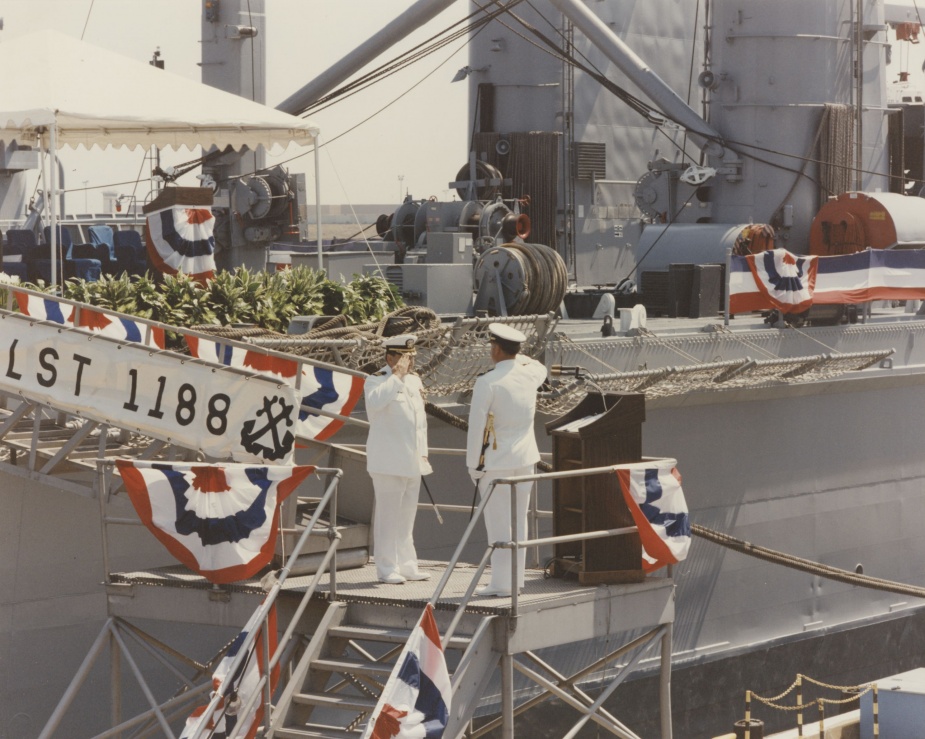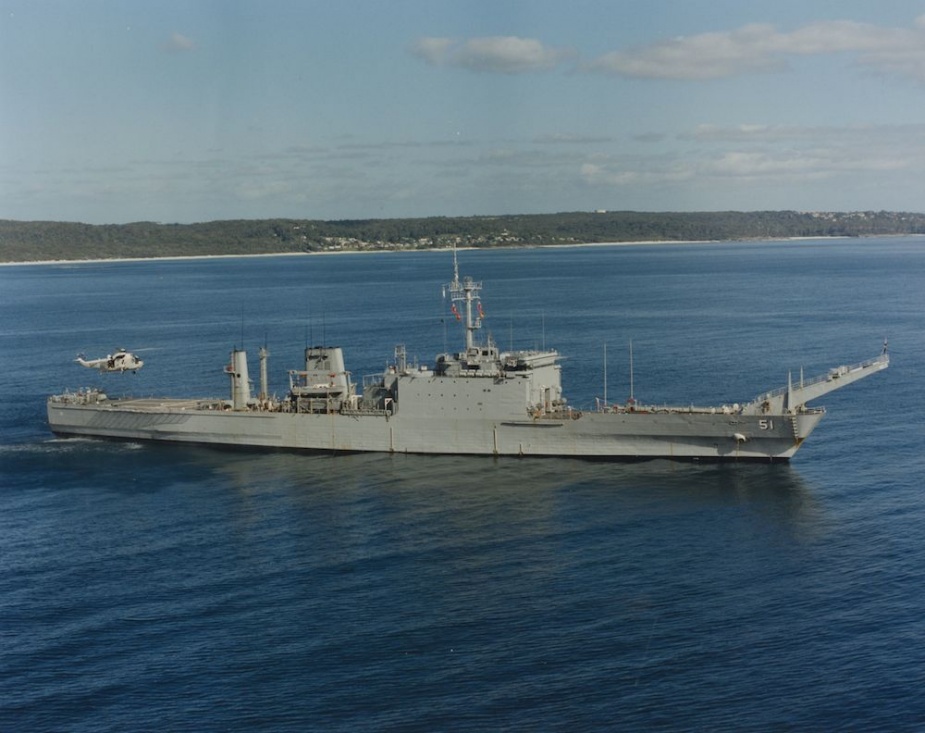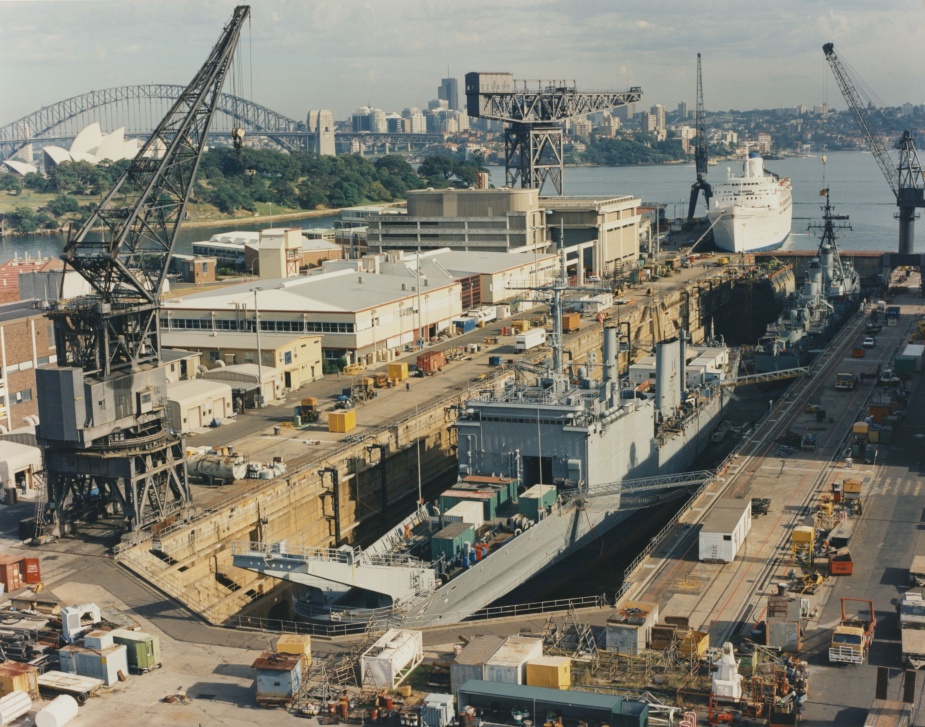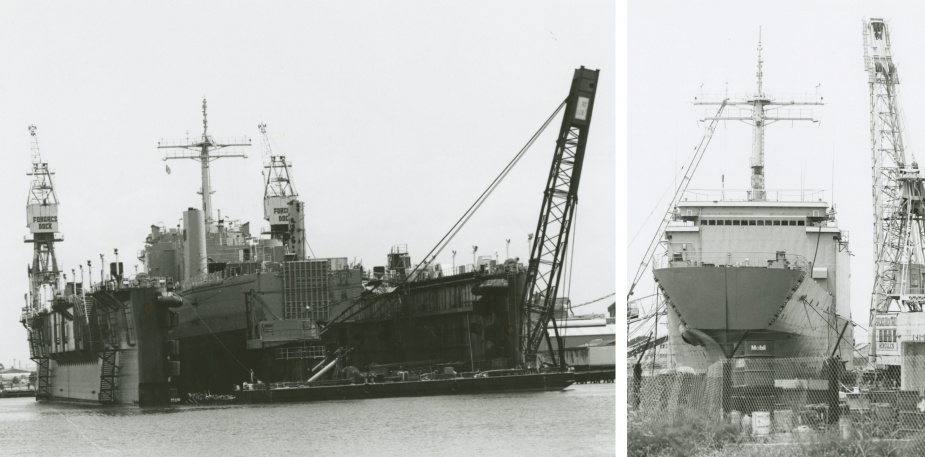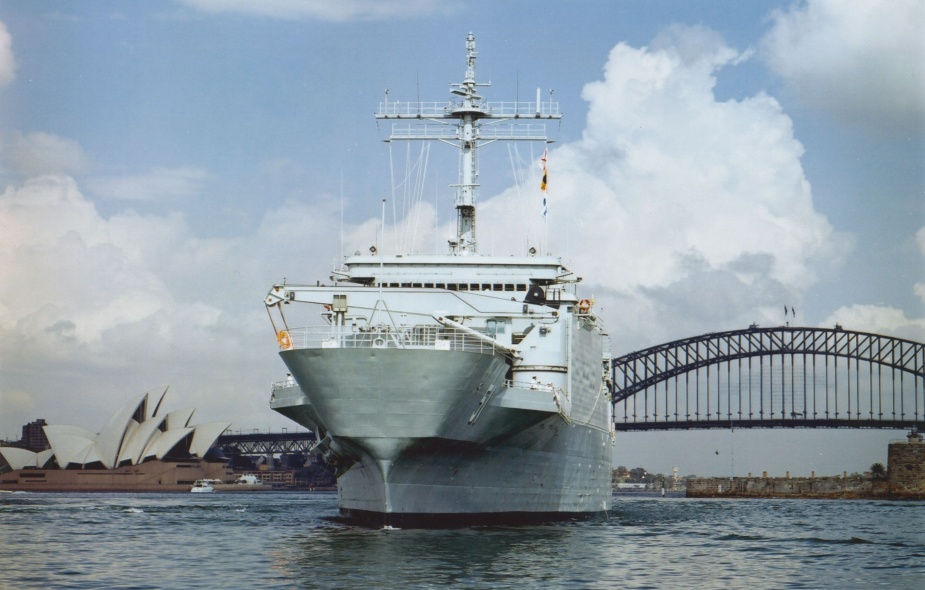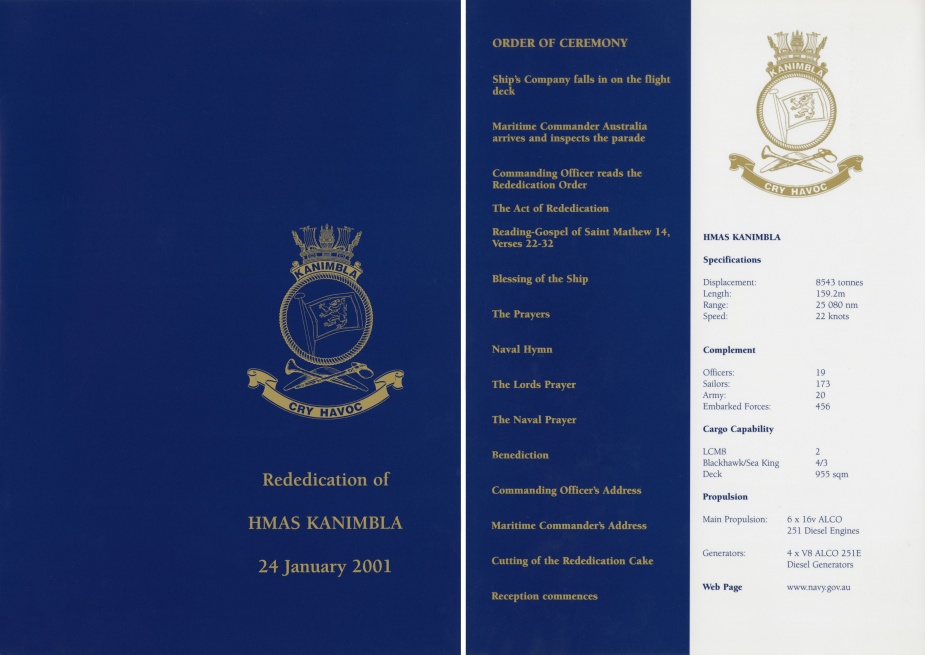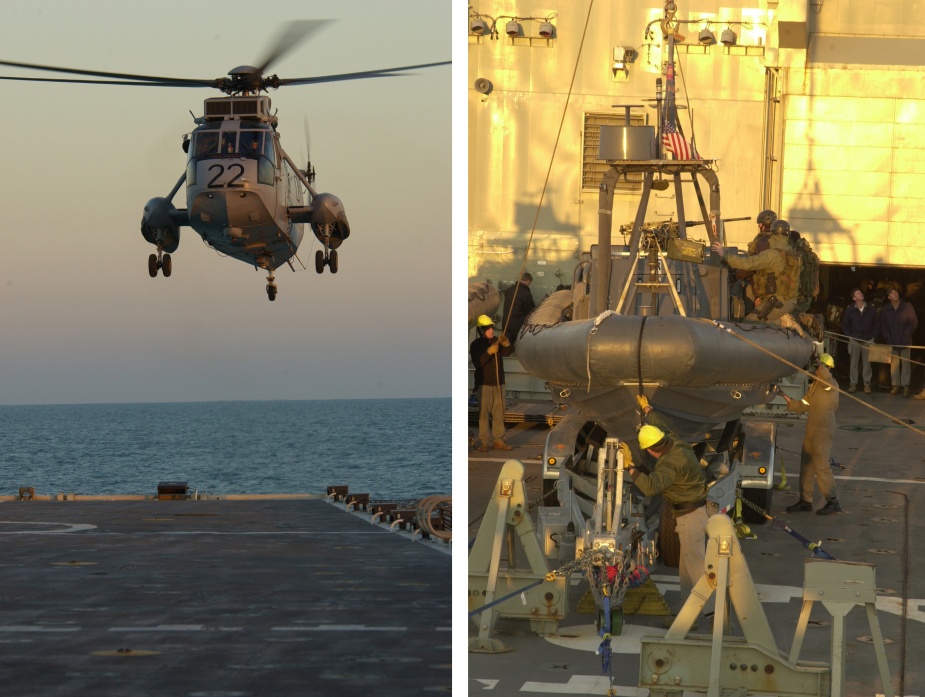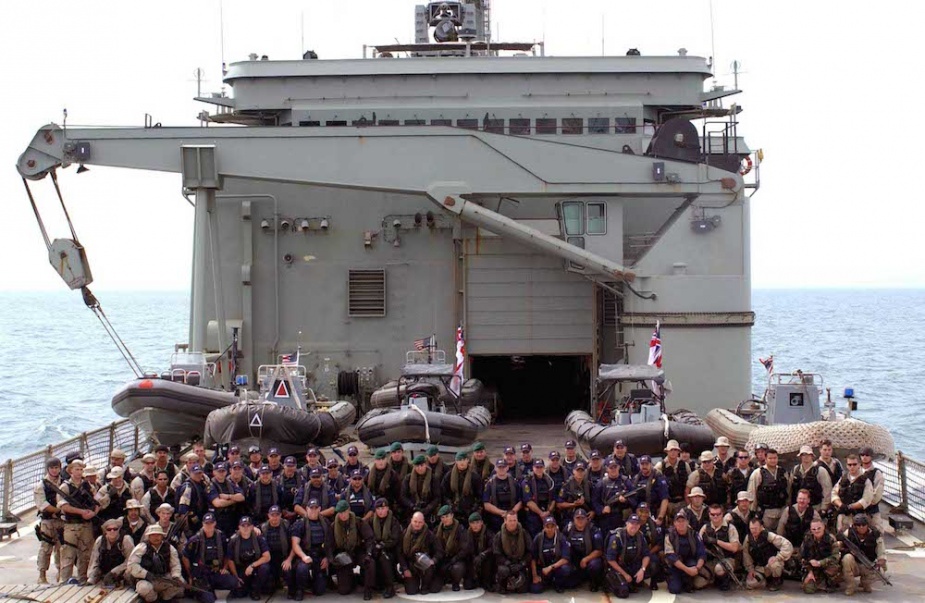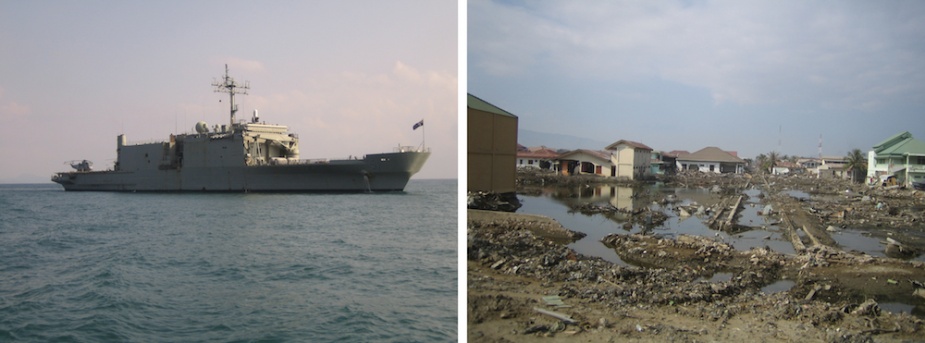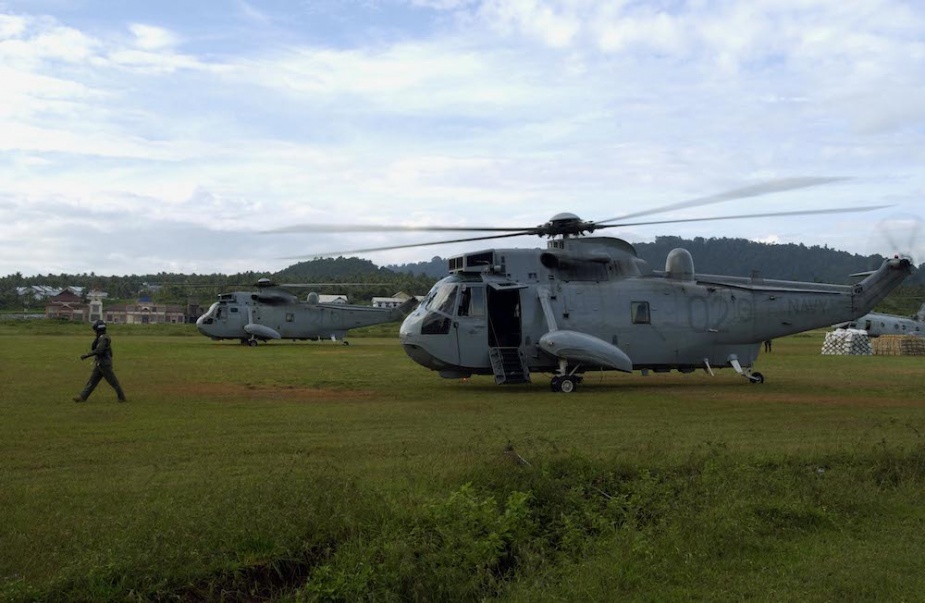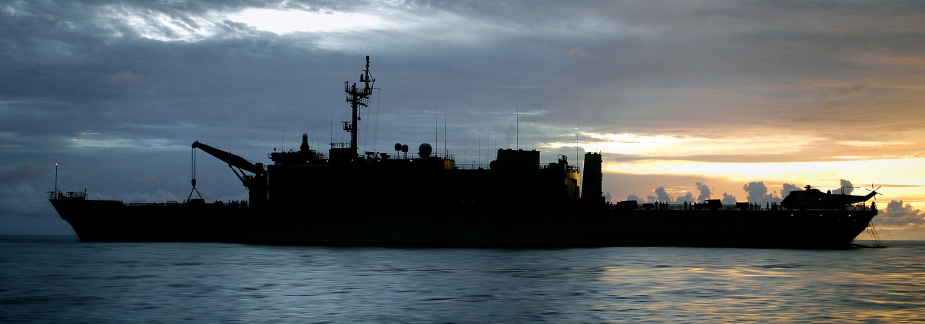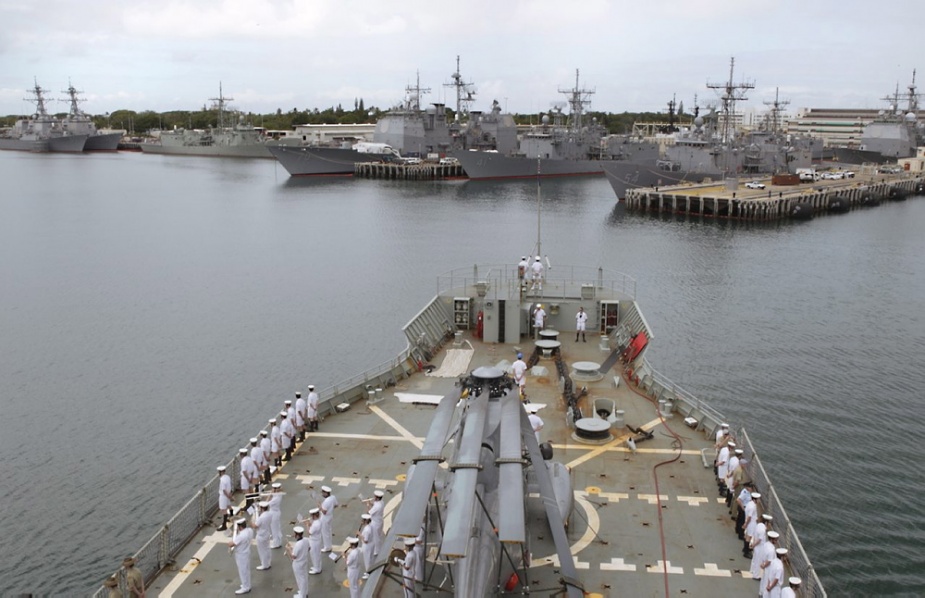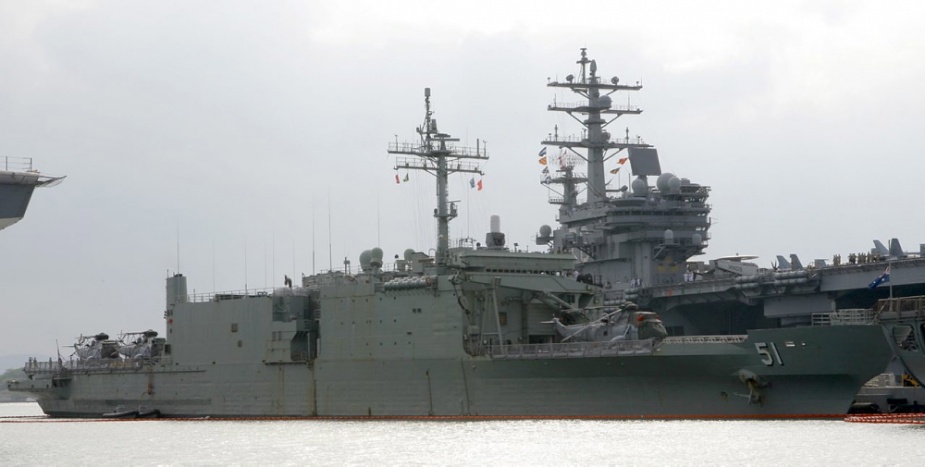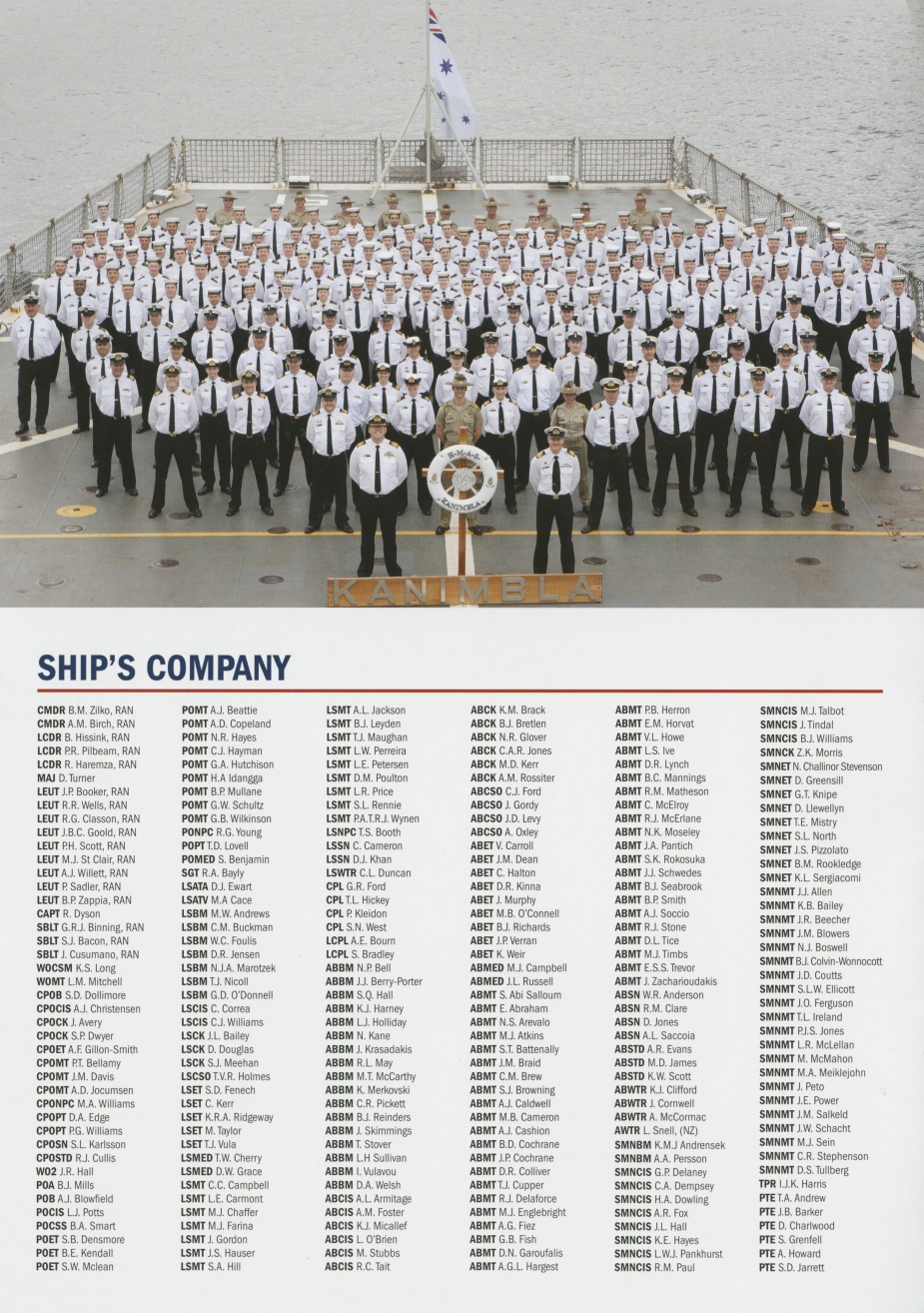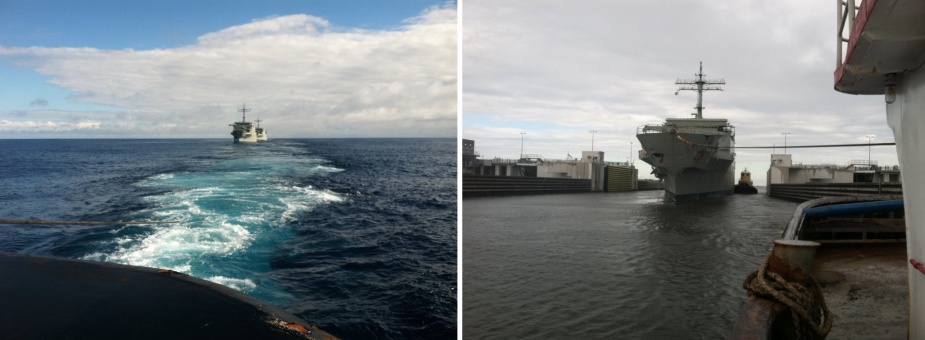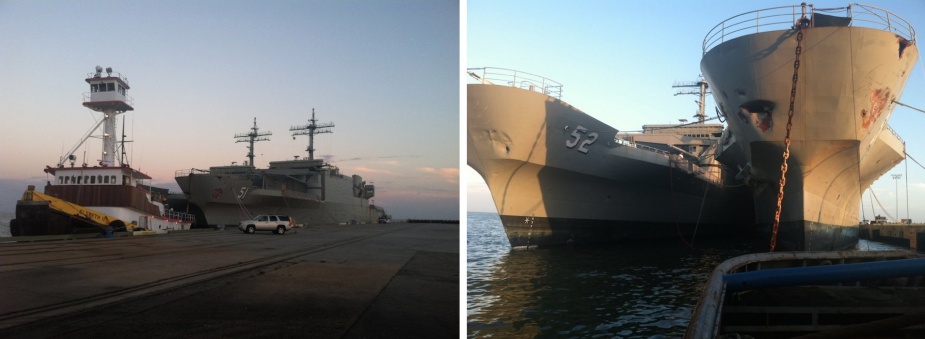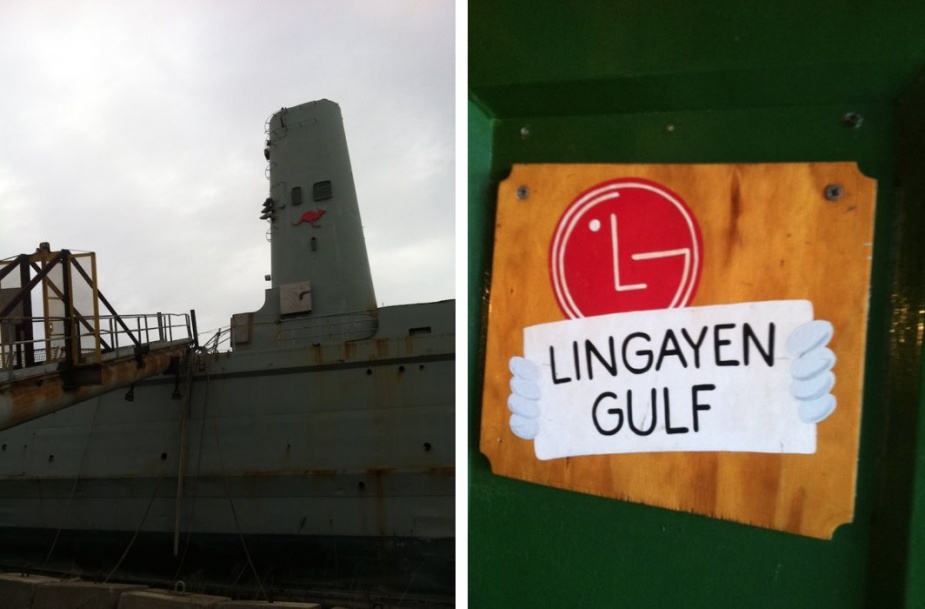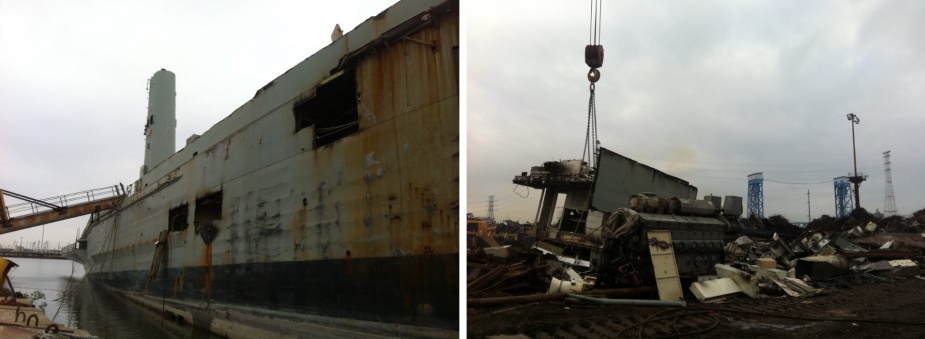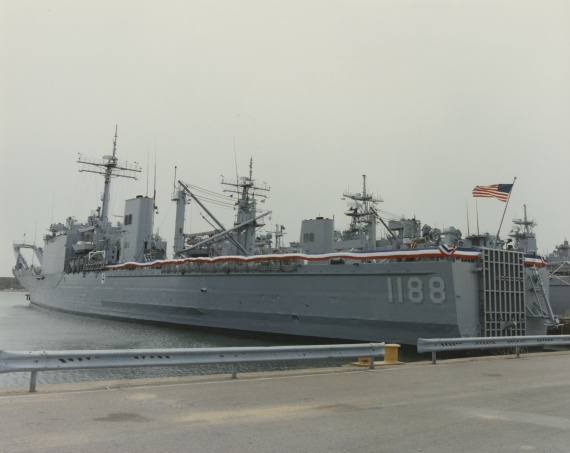
HMAS Kanimbla (II) was one of two former United States Navy (USN) Tank Landing Ships purchased by the RAN to bolster its amphibious capability. As USS Saginaw, she first entered service in the USN on 23 January 1971. Saginaw was one of the 1179 Class Tank Landing Ships designed to replace post World War II LSTs.
Saginaw was launched on 7 February 1970, and commissioned on 23 January 1971 at Long Beach, California. After completion of shakedown training, Saginaw joined the Atlantic Fleet on 18 August 1971, as a unit of COMPHIBLANT.
Named after Saginaw county, Michigan, she was the second US Naval Ship to bear the name. The first Saginaw was a 153 ton side wheel steamer that saw service in the latter 19th century.
Saginaw was involved in routine amphibious operations and deployments that included repeated service as part of the US Sixth Fleet as a unit of Task Force 61.
Missions of particular interest in Saginaw"s history include: assignment to the Apollo 17 moon mission in 1972, participation with NATO in Exercise DISPLAY DETERMINATION in 1977, aid in the inter-fleet transfer of the USS Pegasus (PHM-1) in 1979, support of SOLID SHIELD in 1980, participation in the Cuban Refugee Operations in 1980, evacuation of 800 civilians from Lebanon in 1982, participation in Cold Winter 1983, involvement in amphibious Exercise EASTERN WIND 87, presence in TEAMWORK 88 with NATO forces, short notice deployment to the Persian Gulf in support of Operation DESERT SHIELD/STORM (August 90-August 91), involvement in Spanish PHILBLEX and DISPLAY DETERMINATION, and participation in US Marine Corps" BASCOLEX.
During her career in the USN the Saginaw earned two Navy Unit Commendations, a Navy Expeditionary Medal, a National Defense Medal, a Southwest Asia Service Medal, an Humanitarian Service Medal and a Sea Service Medal.
Fiscal year 1994 began with a determination that Saginaw would decommission in June that year and be turned over to the Royal Australian Navy. In February 1994, the "Hot Ship" turnover process began with the arrival of the standby Royal Australian Navy crew. The Saginaw was subsequently decommissioned by Admiral Picotte, Commander, Amphibious Group TWO on 28 June 1994. Delays in the legislative process surrounding the official transfer of the ship to the RAN saw the Saginaw deemed "In Service Special", and assigned a caretaker crew that was derived from the decommissioning crew members to maintain the ship in working order until the legislation was passed.
Saginaw was officially handed over to the RAN and commissioned as HMAS Kanimbla on 29 August 1994 in a ceremony conducted in Norfolk, Virginia.
Soon after commissioning Kanimbla"s crew underwent lighting off examinations prior to commencing a two-week sea safety assessment period and work ups. On completion she sailed for Australia on 18 October 1994 arriving in Sydney on Friday 18 November where she was greeted by a large contingent of family and friends.
Between August 1995 and December 2000, Kanimbla underwent an extensive modernisation in Sydney and Newcastle to convert the vessel to a Landing Platform Amphibious (LPA). Work included extensive hull preservation work, asbestos removal, installation of an electronic propulsion control system, the fitting of a 70 tonne crane, an engineering and sensor upgrade, installation of a modern medical facility, a new communications centre and modifications to the helicopter hangar.
On 11 December 2000 Kanimbla rejoined and following a redidication ceremony held on 24 January 2001, she began a commission in the RAN that would see her actively participate in National and coalition operations which spanned from the Western Pacific to the Middle East.
One of her first duties in 2001 was as the flagship for the Australia Day Regatta. This was followed by a busy period of post refit defect rectifications and work ups. In May she took part in Exercise TANDEM THRUST before providing humanitarian assistance to the community of the island of Paami, Vanuatu, which had been affected by a volcanic eruption.
In July 2001 Kanimbla was assigned to Operation TREK supporting the International Peace Monitoring Team in the Solomon Islands providing logistic support and undertaking routine patrols. She returned to Sydney in August for a brief maintenance period before departing for the Middle East on 23 October as part of the maritime force assigned to Operation SLIPPER.
Kanimbla entered the Middle East Area of Operations on 2 December, and on 8 December she assumed the duties of Commander Task Group. Between December 2001 and March 2002 Kanimbla was actively involved in operations in the Persian Gulf which ranged from the provision of boarding parties and the transfer of vehicles, to acting as a forward operating base for US Navy SEAL teams. Kanimbla"s return voyage to Australia saw her visit Thailand, Singapore and Cairns before arriving in Sydney on 3 April to a warm welcome from family and friends.
Between 3 April and 31 May the ship entered an assisted maintenance period before sailing for Queensland waters where she conducted an intense period of flying, operating both Blackhawk and Sea King helicopters. A brief port visit to Weipa followed on 6 June before chopping to the operational control of the Commander Joint Task Force 639 for duties with Operation RELEX II. Kanimbla anchored in Darwin Harbour between 10-14 June for Operation RELEX II briefings and a period of boarding party training. On completion she sailed for Christmas Island to unload cargo, arriving there on 19 June. She returned to Darwin on 23 June before again sailing for Christmas Island with Transit Security Element (TSE) 19 embarked to commence RELEX II duties.
Between June and August Kanimbla variously performed the duties of Eastern/Western Surveillance and Response Group Commander for Operations RELEX II. She reverted to the operational control of the Maritime Commander on 19 August and returned to Sydney on 24 August for a brief leave period and maintenance.
The remainder of 2002 saw Kanimbla participate in Exercises SWIFT EAGLE and TASMAN LINK before entering a further maintenance period on 9 November.
The new year found Kanimbla alongside Fleet Base East preparing for work-ups and a further deployment to the Middle East. She sailed from Sydney on 20 January 2003 where she began working up in the Eastern Australian Exercise Area. She briefly returned to Sydney on 24 January where she hosted the Governor-General, Prime Minister, Leader of the Opposition and other dignitaries before departing for Darwin where she arrived on 30 January.
On 4 February 2003 Kanimbla departed Darwin for her second deployment to the Persian Gulf in support of Operations BASTILLE and, later, FALCONER, entering the Middle East Area of Operations on 15 February. There she again served as the platform for the Australian Task Group Commander as well as playing a significant role in the lead up to, and during, the 2003 Gulf War. Kanimbla was central to the clearance of the Khawr Abd Allah waterway, the body of water lying between Iraq and Kuwait leading to Umm Qasr, and was tasked with controlling the exodus of local shipping and coordinating the Coalition forces’ small boat effort. In early March, Kanimbla embarked eight rigid hull inflatable boats and nearly 130 British and American boarding party and support element personnel.
From 17 to 19 March, Kanimbla also supported Sea King, early warning helicopters operating from the aircraft carrier HMS Ark Royal. When hostilities began on the evening of 19-20 March 2003, Kanimbla played a pivotal part in intercepting Iraqi vessels and was the controlling and coordination vessel for the hundreds of patrols conducted in the Khawr Abd Allah waterway. Kanimbla also provided round-the-clock support for Coalition helicopters while her own Sea King helicopter provided logistic support to other Coalition vessels and Australian Clearance Diving Team Three ashore in Iraq. Later, Kanimbla became the first Coalition vessel to supply urgently needed medical supplies to civilian hospitals in Baghdad.
On 14 June 2003 Kanimbla departed the MEAO after 117 days in theatre, for which she was awarded a Meritorious Unit Citation. Between August-September 2003 Kanimbla participated in Exercise CROCODILE 03 conducting amphibious exercises with Australian Army and United States Navy units. The remainder of the year was spent undergoing maintenance.
In February 2004 Kanimbla visited Hobart where she performed the role of flagship for the Royal Hobart Regatta before resuming her amphibious role that saw her participate in Exercises SEALION, SEA EAGLE, SINGAROO and SWIFT EAGLE.
On 31 December 2004 Kanimbla sailed from Sydney for Indonesia via Darwin for Operation SUMATRA ASSIST in the wake of the Boxing Day Tsunami. She entered the Area of Operations (AO) on 11 January and was soon playing an important humanitarian relief role. Kanimbla’s arrival in Singapore on 26 March 2005 marked the end of the operation. However, three days later she was redeployed in support of Operation SUMATRA ASSIST II to provide humanitarian aid to the community of Nias Island following an earthquake.
It was during this operation that tragedy struck when one of Kanimbla’s two Sea King helicopters, ‘Shark 02’, crashed near the village of Amandraya resulting in the deaths of nine ADF personnel. Two crew members survived the crash. In spite of this blow, Kanimbla remained on task returning to Australia in April.
The remainder of 2005 saw Kanimbla participate in Exercises KAKADU, SEALION and SEA EAGLE; Operation RELEX II and provide logistical support to the Army ATSIC Community Assistance Program. She then entered a prolonged maintenance period that extended from November 2005 to April 2006.
On 11 May 2006 Kanimbla departed Sydney for East Timor via Darwin to participate in Operation ASTUTE (the ADF relief to East Timor). She entered the AO on 25 May and was soon providing much needed logistic support to elements deployed ashore. She departed the AO on 18 July.
Following a brief maintenance period, Kanimbla deployed on 31 October 2006 in support of Operation QUICKSTEP, the ADF contingency operation to evacuate Australians from Fiji in the face of an emerging coup. This operation was marred, on 29 November 2006, by the loss of an Australian Army Blackhawk helicopter which crashed while attempting to land on Kanimbla’s aft flight deck. It was lost over the side of the ship, resulting in the deaths of two of the ten crew members.
On 13 December 2006 Kanimbla was released from Operation QUICKSTEP and returned to Australia where she entered another prolonged maintenance period.
During 2007 Kanimbla participated in; Exercises SEA LION, TALSIMAN SABRE and TOOTHFISH; and Operations RESOLUTE and DELUGE (the ADF contribution to security of the APEC Economic Leaders Meeting).
In January 2008 Kanimbla acted as the flagship for the annual Australia Day Regatta before resuming a routine exercise programme that saw her participate in exercises CROIX DU SUD in New Caledonia, and MARS HARPOON.
Throughout 2009 Kanimbla participated in; Exercises SEA LION, TOOTHFISH, TALISMAN SABRE, OLGETTA WARRIOR and HELICON LUK. In October that year she also took part in Operation PADANG ASSIST following an earthquake that devastated that area on 30 September.
Kanimbla arrived back in Darwin on 5 November 2009 before returning to Sydney in time for Christmas and routine maintenance.
Between June-July 2010 Kanimbla took part in the Rim of the Pacific (RIMPAC) Exercises held in the Hawaii Operations Area before returning to Sydney.
On 21 September Kanimbla experienced a fire in number 3 engine room while exiting Sydney Harbour. The fire was quickly controlled and the ship returned to Fleet Base the next morning. Following that incident both HMA Ships Kanimbla and Manoora (II) were placed on an operational pause on the advice of the Seaworthiness Board.
It was subsequently decided to retire Kanimbla from service and she decommissioned at Fleet Base East, Sydney, on 25 November 2011.
Epitaph
On 24 June 2013 the then Minister for Defence Materiel, Dr Mike Kelly AM MP, announced the sale of Kanimbla and her sister ship Manoora to Southern Recycling LLC located in New Orleans, Louisiana, USA. Notwithstanding their recent service in the RAN, the disposal of the two former US Navy ships required US Government consent in accordance with US International Traffic in Arms Regulations.
Contract negotiations were completed in early May 2013 and the disposal contract was signed on 20 May 2013. Both ships were subsequently towed in tandem, by the ocean going tug Salvage Ace across the Pacific Ocean and through the Panama Canal where the tow was taken over by the Smith Maritime tug Elsbeth II on 12 September 2013. From Panama they were towed to Gulfport Mississippi arriving there on 3 October 2013.
From Gulfport, the two former warships were towed independently to their final destination, Southern Recycling, where they were cut up for scrap.
Specifications
 |
| Class |
Kanimbla Class |
|---|---|
| Type |
Amphibious Warfare |
| Pennant |
L51 |
| Launched |
7 February 1970 |
| Commissioned |
29 August 1994 |
| Decommissioned |
25 November 2011 |
| Dimensions & Displacement | |
| Displacement | 8534 tonnes |
| Length | 159.2 metres |
| Beam | 21.2 metres |
| Performance | |
| Speed | 22 knots |
| Complement | |
| Crew |
|
| Embarked Forces | 400 embarked forces |
| Capacity |
|
| Propulsion | |
| Machinery | 6 x ALCO V16 diesel engines, 2750 HP each, 3 engines per shaft |
| Armament | |
| Guns | 6 x 12.7mm machine guns |
| Other Armament | 1 x 20mm Phalanx MK15 close-in weapon system |
| Awards | |
| Inherited Battle Honours |
|
| Battle Honours |
|
